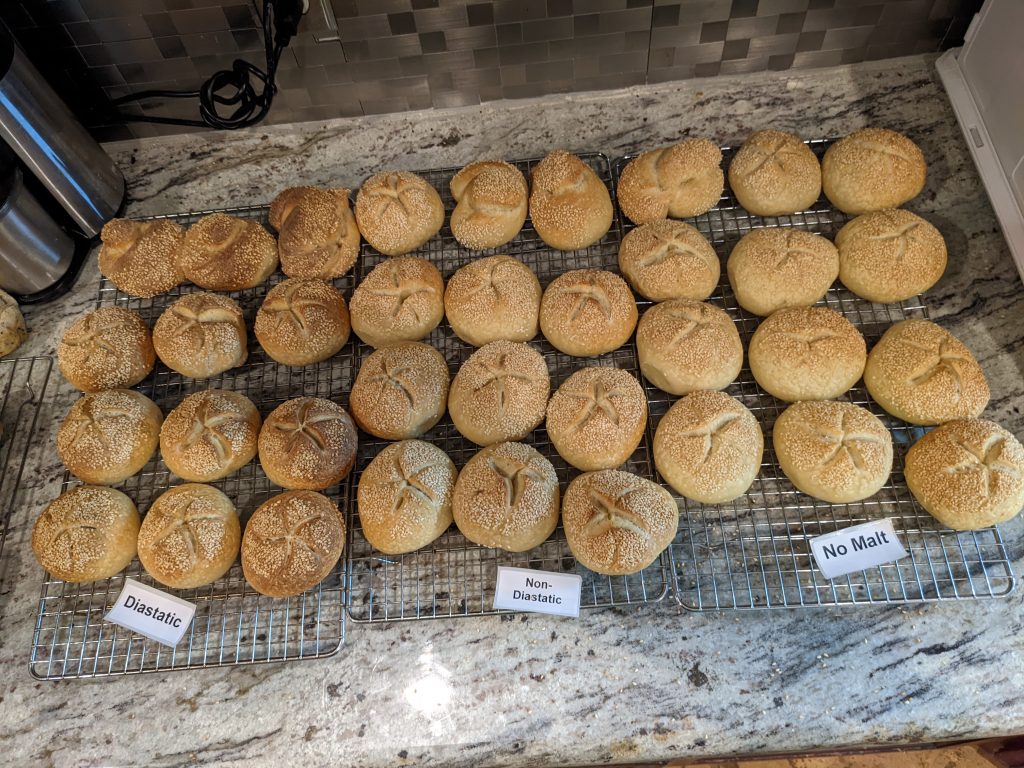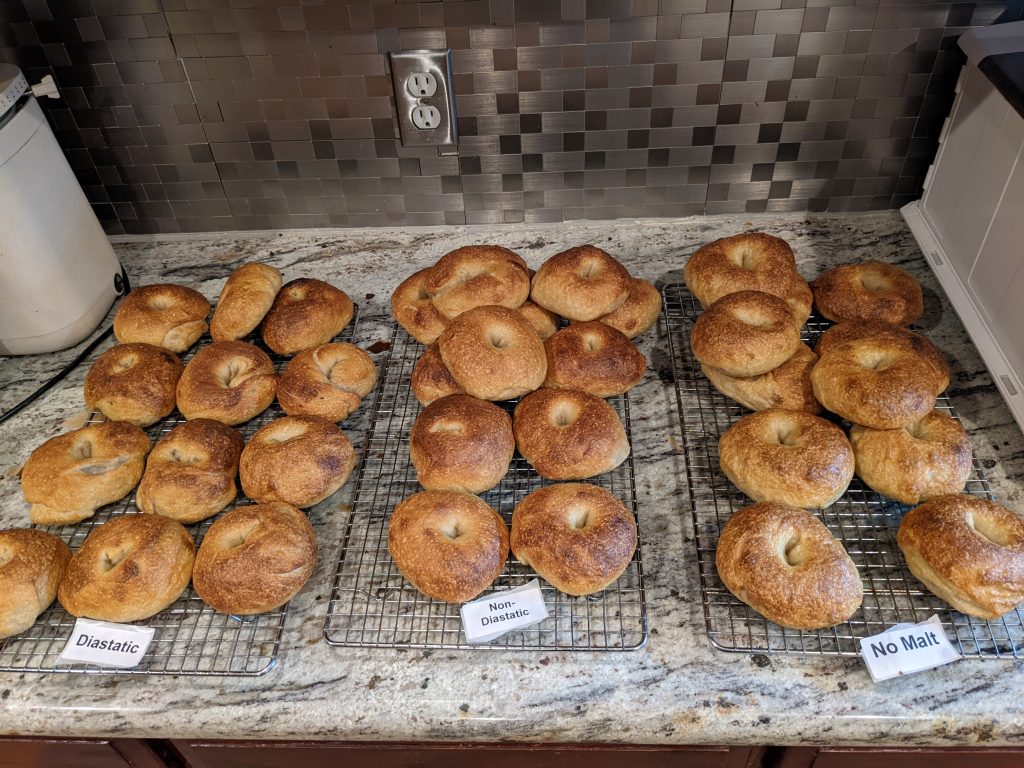
2022-01-09 The Great Malt Shootout, Part 1
This post was first sent out as a newsletter to the Mike's (More or Less) Weekly Baking Tips. If you subscribe, you'll get these posts before (often MUCH before) they hit the web page, and it's free. It will take a court order to make us share your contact information, and we won't send you advertisements. If you want to subscribe, just go to the subscription page.
A touch of malt for the New Year please! Let's start by wishing you, and your families, the happiest of new years! Let's all hope, pray and work to make this one a better one than the last!
To that end, we're going to start with a touch of malt. And fermented malt at that! However, not a beer or liquor, just malt in baked goods. This note has taken longer to write than most, words just haven't flowed very easily. Hopefully the wait will have been worth it!
To recap - in the last exciting issue of this newsletter we talked a bit about the impact of malt extract on baked goods, prompted because a reader asked whether he should use diastatic or non-diastatic malt to make our Sourdough Kaiser Roll recipe. Malt extract adds flavor to baked goods, it helps with crust color, and helps the yeast do its job. Sometimes a flour mill will add malt extract to their flours to help boost the enzymatic activity of the flour. Check your flour labels. This is most commonly done to ensure they create a consistent product, or when the flour isn't very good - perhaps due to a poor harvest.
Wikipedia has a wonderful article on malt which explains what malt is, how it is made and the difference between diastatic and nondiastatic malt far better than I could, or will. They tell us that malt is germinated cereal grain that has been dried in a process known as "malting". The grain is made to germinate by soaking in water and is then halted from germinating further by drying with hot air. As all grains sprout, natural enzymes within the grain break down the starch of which the grain is composed into simpler sugars, which taste sweet and are easier for yeast to use as food. The sugars are extracted from the malted grains by soaking them in warm water and then drying the solution. Malt extract with active enzymes is called "diastatic malt extract". Malt extract with inactive enzymes is called "nondiastatic malt". The enzymes are deactivated by heating the malt much above 155F. Without malt, we wouldn't have beer or whiskey or whisky!
Getting back to the original question, will a diastatic or nondiastatic malt extract be better for our baked goods, in particular Kaiser Rolls and bagels? That led to "Experiment Time!" Sadly, the brewing shops I checked did not have diastatic malt, and couldn't even get it. Amazon had diastatic malt extract, so I ordered from them. I'd hoped to find an otherwise identical malt extract in diastatic and nondiastatic varieties, but that was not to be. However, I found two light malt extracts that should be similar.
In order to answer the question, I made three batches each of Kaiser Rolls and bagels. One with no malt, one with nondiasatic malt, and one with diastatic malt. The same formula was used for each batch, other than the malt.
Kaiser Rolls, also called Emperor Rolls, or Kaiser Semmeln. These were one of our favorite products and we must have made millions of them in the bakery. When the Denver Post wrote an article about the best hamburgers in Colorado, they selected the burgers at the Gas Cafe in Crested Butte as one of the 10 best and specifically mentioned the great buns they used. Which we provided. Which made us smile! I miss the Gas Cafe in Crested Butte, and I miss their burgers and breakfast sandwiches. When we were selling at the CB Farmers Market I'd help set up our booth and go to the Gasser to get the gang breakfast. It takes a certain bizarre humor to name your sandwich a "Quadruple Bypass", but with bacon, sausage, ham, egg and a hash brown on it, it might be warranted. That is SUCH a good sandwich - what an Egg McMuffin wishes it could be. But I digress. Our Kaiser Roll recipe is at sourdoughhome.
The interesting thing was the doughs made with malt extract seems stiffer than the no-malt dough, and that the dough with the diastatic malt felt like it was stiffer yet, as if it had a lower hydration. All the doughs rose nicely, were shaped, and allowed to rise overnight at 48F.
When the smoke cleared, all of the rolls looked, and tasted, great. The rolls made with non-diastatic malt extract were a bit darker than the ones made without malt extract. The ones made with diastatic malt extract were, again, slightly darker than the ones made with the nondiastatic malt extract. The crust, crumb and taste of all three rolls were very similar.
Being methodical - some would say obsessive - I measured the diameter, height, and weight of the rolls from each dough. And, of course, determined the average and standard deviations on the sizes. All sizes are in millimeters, all weights in grams.
| Kaiser Sizes | No Malt | Non-Diastatic Malt | Diastatic Malt |
|---|---|---|---|
| Diameter | 91.9 | 89.9 | 84.6 |
| Standard Deviation | 2.32 | 3.62 | 1.94 |
| Height | 48.9 mm | 47.2 mm | 47.3 mm |
| Standard Deviation | 5.93 | 3.23 | 3.09 |
| Weight | 81.8 grams | 83.9 grams | 81.4 grams |
| Standard Deviation | 2.05 | 1.90 | 1.67 |
What this tells us is that the diastatic rolls spread less than the nondiastatic malt rolls which spread less than the no-malt ones. This is what you'd expect of a firmer dough. The malted doughs rose to about the same height, but not as high as the non-malted dough.
It isn't clear that the variations in the roll weights is significant. It is interesting that the standard deviation in the malted rolls was lower than in the non-malted dough, with the diastatic having the lowest variation. Again, it isn't clear what this means. I invite your speculation.
Tom Swift and the Strangely Flaccid Bagels Or, you learn more from a single failure than a thousand perfect batches! Which brings us to the bagels. Bagels are one of the most unusual breads you'll ever bake. Our recipe for sourdough bagels is, we feel, a great one. We've gotten lots of praise over the years for both our bagels and the recipe. This time.... well, anyone can have an off day. Our late subscriber Joseph Brooks, always told me to never admit making a mistake. Sorry Joe, I gotta be honest, and the mistake is very instructional!
The process of making bagels is a little tricky, a little long, and very important. Bagels should get a long overnight rise to fully develop their flavor. Then bagels are boiled to set the crust and give them a nice sheen. Ideally, when a bagel is put in the boil it should sink and then float in about 15 seconds. If it sinks and does not rise within a minute or so, it needs to rise longer. (Side note - sometimes a bagel will stick to the bottom of the boil pot - touching them with a spatula will free them and often let them float.) If a bagel floats right away, it was allowed to rise too long and the only solution is not not let them rise so long next time. This simple rubric ensures the right density in the baked bagel. If your bagels don't float, let them rise a bit longer. If your bagels float right away, your bagels will be too light. They'll taste fine, but they won't have the right texture, so cut the rise time, or temperature, next time.
All of our bagels were boiled in about 2 gallons of water with 2 generous tablespoons of nondiastatic malt extract. In retrospect, perhaps I should have boiled the non-malted bagels in plain water, but I reflexively boiled them in malted water. Since the diastase enzyme breaks down at about 155F, I saw no reason to boil the bagels in a bath with diastatic malt extract - the enzyme would be deactivated before the first bagel took a bath. Still, there were differences between the three batches.
All that brings us to the bagel batch. Or bagel botch. The last few batches of bagels we've made have not been rising enough overnight, so I increased the temperature of the wine cooler from 55 to 65F. That was compounded by not attending to the bagels first thing in the morning, but instead going to the gym, a hardware store, and the grocery store before getting back to the bagels. The bagels had spread out considerably, losing their nice round cross-section. The floated as soon as they touched the water.
The last time I made bagels this ugly was in a class where someone asked, "what happens if you boil the bagels too long?" At about 5 or 6 minutes, they really lose their shape - you can only push the protein so far! One minute per side seems to be optimum, and rise time is very important.
As with the Kaiser rolls, the dough made with the diastatic malt extract was firmer than the dough with no malt or the non-diastatic malt extract. Some of the bagels made with diastatic malt were close to being good. All of the bagels were better than I've gotten from many bagel shops, and much better than grocery store bagels, but they really weren't what I was shooting for.
Once again, the bagels made with diastatic malt were darker than those made with nondiastatic malt, which were darker than the no-malt bagels. Some people may ask, "what about using honey?" I've never done that, so I can't comment on it. However, if you use honey, your bagels won't be acceptable to vegans.
As with the Kaiser rolls, I measured the bagels to compare them, but I also graded them on their shape, giving them a grade from 1 to 10. 1 is "I wouldn't give it to my dog, and my dog will eat ANYTHING!" while 10 is "A perfect bagel!" 5 would be the score for a run of the mill grocery store bagel. This was a totally subjective evaluation, and it would have been better if someone other than the baker had evaluated the bagels.
| Bagel Sizes | No Malt | Non-Diastatic Malt | Diastatic Malt |
|---|---|---|---|
| Diameter | 114.5 mm | 110.3 mm | 106.8 mm |
| Standard Deviation | 6.2 | 5.9 | 6.4 |
| Height | 37.7 mm | 39.2 mm | 39.1 mm |
| Standard Deviation | 4.9 | 3.2 | 4.5 |
| Weight | 118.6 grams | 12.3.2 grams | 123.5 grams |
| Standard Deviation | 3.6 | 6.9 | 4.3 |
| Shape Grade | 3.3 | 5.2 | 5.5 |
| Standard Deviation | 1.7 | 0.8 | 1.6 |
As mentioned above, as with the Kaiser rolls, the dough made with the diastatic malt extract seemed firmer, as if it had a lower hydration. This translated into a better shape for the bagels, despite the bagels having been severely over-risen. As with the Kaiser rolls, the bagels made with malt extract spread less and weighed more.
And that brings us to the $64,000 question. Which, if any, malt extract should you use in your Kaiser rolls and bagels? At the end of the bake, using no malt extract was better than I was expecting. If you are out of malt, you can leave it out. The malt police may not even know, but you will. I really do like the results with the malt extract added, but am not convinced that the additional cost of diastatic malt extract is justified. If you aren't getting the browning or rise you want in your baked goods, you might try adding 3 to 5% malt extract.
And now, the other shoe drops. Reading the early parts of this note about when and why flours are malted and my admonition to read the labels prompted me to... read the label. The flours used in this baking test were King Arthur's Sir Galahad and Honeyville's Imperial High Protein flour. Both, it turns out, are malted flours. I am looking around for flours with no added malt to re-run these tests. It looks like the all-purpose and all-purpose premium flours at Barton Springs Mill are unmalted. More as things develop.
Until next time, may your dough always rise whether the malt is in your flour or in your glass,
-Mike




Hello! I found you on YouTube, in a search concerning Ankarsrum’s dough hook, which I use. I also grind my own grains. We live in very rural Alabama. And I have friends who are now interested in the grinding of the grains, etc. (Only took 20 years and an economic downfall!!!) I LOVE this post. The husband travels the country, working on Krispy Kreme Doughnut equipment. Yes, he can make a doughnut the original way. Mother, Mother, where are you?!?!?! Waiting to me started, said she!!! I am going to enjoy reading from your blog! And I will invest in your printed cookbooks. Take care, sir, to you and yours. (The husband brought home the shaker stuff for the top of the rolls, whose name I have seen, but cannot remember!!! But I will find it!!! 🙂 🙂 🙂 ) Blessings and Re Jouir -Darlene (& Scott)
Hi Darlene,
Thanks for the kind words! Let us know how your, and your neighbor’s, journey with home milled grain goes!
Best wishes,
Mike